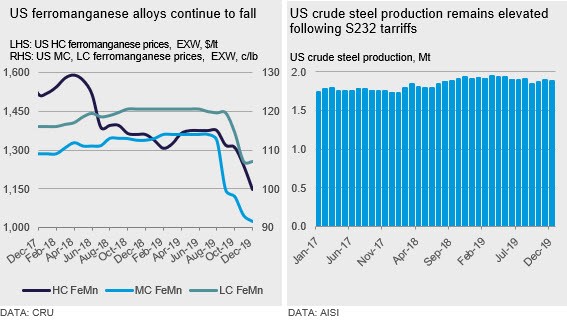Steel Products Prices North America

CRU: U.S. Ferroalloys Trade Lower
Written by CRU Americas
January 7, 2020
By CRU Analysts, from CRU’s Bulk Ferroalloys Monitor
U.S. finished steel prices have risen following price increase announcements that found support from service center restocking. Adding to this price support was the scrap market, where scarcer supply and increased mill demand put prices on an upward trajectory. Some steel products have enjoyed quicker price gains than others.
Since the end of October, mills have announced a total of four price increases for sheet products. The most recent increase targets $640 /s.ton for HR coil. These announcements have come amid renewed activity in service center shipments, with the November Service Center Report from Steel Market Update showing evidence of stronger-than-expected shipments and elevated levels of material on order. Traditionally, November shipments fall from October. However, this year, outbound shipments from service centers may have risen as steel users further down the value chain tried to get ahead of higher prices. More important to our analysis is that this report shows clear evidence of higher levels of inventory on order. The strongest market during this price upswing has been HR coil, where current prices were assessed at $570 /s.ton, a gain of $69 and $126 /s.ton from the respective Nov. 20 and Oct. 31 price assessments.
For long products, seasonal restocking has continued to lift demand ahead of the new year as import levels remain low. As a result, lead times for some long products are expanding, halting ongoing price decreases for the first time since April. For wire rod, more rod mills are closing in on six-week lead times as large buyers look to replace a big part of their inventories. Rebar was an exception to finished steel price increases this month because of seasonally weak demand.
HC Ferromanganese Spot Prices Follow Contracts Lower
U.S. HC ferromanganese prices decreased to the end of December, as prices previously seen only in long-term deals became available in the spot market. HC ferromanganese prices declined by 7.5 percent m/m in December to $1,147.7 /l.ton, EXW, down from $1,240 /l.ton, EXW, in November. Market sources said they do not view any upside to start 2020, although further price cuts are unlikely.
Market sources said that sellers were not successful in reining in discounts for long-term contracts for 2020, despite the fact that ferromanganese prices fell significantly last year. Discounts for ferromanganese are reported to have increased, which will limit spot business.
U.S. MC ferromanganese prices also edged lower, down by 1.7 percent to 91.5 c/lb, EXW, in December from 93.1 c/lb in November. U.S. LC ferromanganese prices remained flat m/m at 107 c/lb, EXW. Similar to HC ferromanganese, there is no visible upside for MC and LC ferromanganese prices.
Prices for U.S. manganese metal were flat through December as spot demand remained limited. Consumers have sufficient material through contracts for the time being, but some expect that contract volumes for 2020 will be down, improving spot demand. The market should remain steady for the time being until there is an improvement in demand.
Ferrosilicon Prices Under Pressure
U.S. ferrosilicon prices edged down by 2.3 percent m/m at 75.8 c/lb, EXW, in December, down from 77.6 c/lb in November. Spot prices have been volatile as sellers tried to increase prices in line with higher replacement costs, but some traders were willing to offload material at aggressively lower levels.
The near-term outlook for ferrosilicon remains unclear. European prices have increased significantly over the last two months and were up by 10.2 percent m/m. But efforts to push up U.S. prices have been slow to catch on and have been met with resistance.
Silico-Manganese Prices Flat But Demand is Soft
U.S. silico-manganese prices remained unchanged in December at 60 c/lb, EXW. The spot market was inactive over December, insulating the index price from changes seen in other markets. However, we anticipate a drop in prices as the market is well-supplied and demand is subdued.
Outlook: U.S. Manganese Alloys to Remain Under Pressure
The U.S. ferroalloy market is likely to remain under pressure in the near term as it remains well-supplied. Although U.S. steel mills saw a 1.8 percent increase in steel production in 2019 (according to American Iron and Steel Institute data) this was propped up by Section 232 tariffs.
As end-user markets – including agriculture, automotive and energy – softened throughout the year, mills made tough decisions to rationalize capacity. In late December, U.S. Steel announced that it will close the iron and steelmaking operations at its Great Lakes Works in Michigan by April 1. This follows ArcelorMittal USA’s decision to close its 1.44 Mt/y #3 furnace at Indiana Harbor, Ind., and there are likely to be further curtailments.
As a result of the aggressive discounts agreed for 2020 long-term contracts, it looks likely that prices in the spot market will remain under pressure. We do not believe there will be any improvement in the market until supply and demand come into balance. As we noted last month, potential logistics issues on the back of extreme weather conditions in spring could provide some respite for falling prices in the U.S. spot market.

Request more information about this topic.
Learn more about CRU’s services at www.crugroup.com
CRU Americas
Read more from CRU AmericasLatest in Steel Products Prices North America

Nucor maintains plate prices, opens August order book
Nucor aims to keep plate prices flat again with the opening of its August order book.

Nucor CSP remains level at $900/ton
Nucor maintained its weekly list price for hot-rolled (HR) coil this week, following two consecutive increases.

Cliffs raises prices, seeks $950/ton for July spot HR
Cleveland-Cliffs plans to increase prices for hot-rolled (HR) coil to $950 per short ton (st) with the opening of its July spot order book. The Cleveland-based steelmaker said the price hike was effective immediately in a letter to customers dated Monday.

HRC vs. prime scrap spread widens in June
The price spread between HRC and prime scrap widened in June.

SMU price ranges: Steel prices rise in response to tariffs
Steel prices climbed for a second straight week across all five sheet and plate products tracked by SMU.
